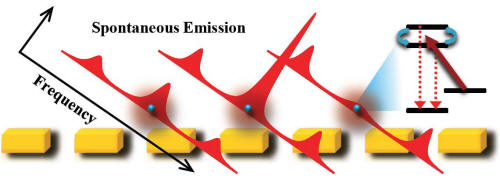Surface-Plasmon-Induced Modification on the Spontaneous Emission Spectrum via Subwavelength-Confined Anisotropic Purcell Factor
Time:2012-04-23ClickTimes:
After observing the plasmon-induced transparency in asymmetric T-shape single slit in this month, Prof. Qihuang Gong, Associate Prof. Ying Gu, and their PH.D. student from the creative team ”Femtosecond physics and mesoscopic optics ”, have demonstrated the line width narrowing of the spontaneous emission spectrum via the anisotropic Purcell factor in plasmonic nanostructures. The work is published in Nano Letters on April 18, 2012 (Ying Gu, Luojia Wang, Pan Ren, Junxiang Zhang, Tiancai Zhang, Olivier J. F. Martin, and Qihuang Gong, Surface-Plasmon-Induced Modification on the Spontaneous Emission Spectrum via Subwavelength-Confined Anisotropic Purcell Factor, http://dx.doi.org/10.1021/nl300655n)。The collaborators also include the researchers from Shanxi University and EPFL in Switzerland.
Recent developments in nanotechnology and information technologies have made nanoscale light-matter interaction a tremendous research focus, which may be applied in the ultracompact nanodevices. Surface plasmon polaritons coming from collective oscillations of free electrons in metals have attracted great interest. By combining the anisotropic Purcell factor induced by surface plasmons in metallic nanostructures with the principle of quantum interference, we proposed the mechanism of using the anisotropic Purcell factor to control the line width of spontaneous emission spectrum. As proof of the mechanism and, in particular, as its application at subwavelength-confined anisotropic Purcell factor, several plasmonic structures were employed and interesting phenomena in the spontaneous emission spectrum appear: atomic spectral line rapid narrowing, nanoscale linewidth pulsing, and dramatic modification, in particular, subnatural linewidth for two orthogonal dipoles, at the nanoscale. The combined system of quantum emitters and plasmon nanostructure may open some perspectives for applications in ultracompact active quantum devices.

|
A nanoscale pulsing of line width of the spontaneous emission spectrum according to the periodical metallic nanostructure
|
In reviewing this paper, the reviewer pointed that “This is a popular and active research direction at this moment” and “The paper bridges the fields of quantum optics and plasmonics that is useful for the field of nanostructures”.
This work is supported by the projects ”the creative team” and “breeding” of great research program from the National Science Funding of China, 973 project from The Ministry of science and technology, and the funding from the State Key Laboratory for Mesoscopic Physics.
